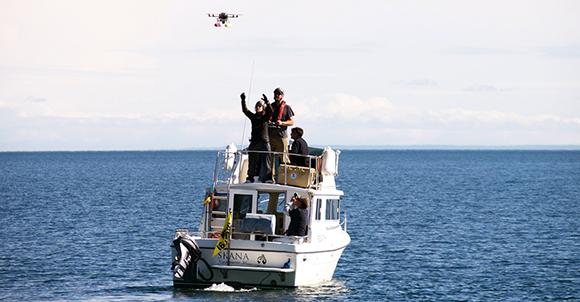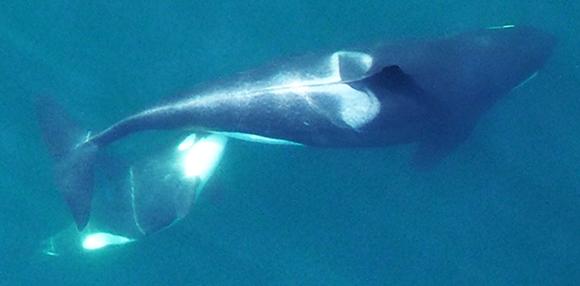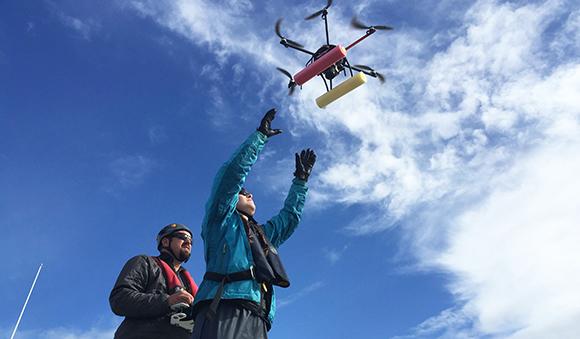
UAV offers new angle for killer whale research
It was a scene that few people, if any, had ever witnessed: An adult male killer whale chasing down a salmon, then carrying it back to his pod and casually releasing it in front of a young mother and her calf.
Seafood dinner, delivered.
About 90 feet above the whales, a camera mounted to an unmanned aerial vehicle (UAV) captured the moment, giving scientists an unprecedented perspective on some the world’s most endangered animals — the Southern and Northern Resident killer whales living in U.S. and Canadian waters near the San Juan Islands.
These aerial photographs — among tens of thousands taken so far — have thrilled scientists and made headlines for offering incredible views of such rare animals. More importantly, these images give scientists a way to accurately measure each animal, gauge its health, and determine growth rates and pregnancies.
“Their body condition can change noticeably over just a few weeks,” said Lance Barrett-Lennard, head of the Cetacean Research Program at the Vancouver Aquarium Marine Science Centre and one of the leaders of the groundbreaking UAV project. “You can’t really tell that by looking at them from a boat — you can only tell when they’re starving, almost to the point of death. But from above, we can determine very accurate length-to-width ratios, and we can see how weight is distributed along their bodies.
“It allows us to conduct a much finer analysis.”
Analysis of those images, termed “aerial photogrammetry,” reveals critical information not only on the behavior and health of individual whales, but also about the effects of variations in the abundance of chinook salmon, the key food source for these particular whales.
In November 2005, the United States listed the population of Southern Resident killer whales as endangered. By the winter of 2015, only 84 individuals remained.
Barrett-Lennard and his colleagues John Durban and Holly Fearnbach first started using a hexacopter drone to study killer whales around the San Juan Islands in 2014. They began with Northern Resident killer whales in Canadian waters. Once they were sure the small drone didn’t adversely affect the whales, the researchers expanded the program across the border to study the Southern Resident killer whales.
The program’s first round of grants, made in the fall of 2015, awarded nearly $590,000 to five projects focusing on prey availability, noise exposure and the development of a standardized health index for the whales — similar to a medical chart for each remaining animal.
One of these NFWF grants, for $250,000, was awarded to the Vancouver Aquarium to support the aerial photogrammetry project. The funds will help pay for field expenses and countless hours of analyzing terabytes worth of imagery, Barrett-Lennard said.
During the announcement of the grant slate, SeaWorld CEO Joel Manby emphasized that increasing support to field researchers was critical to helping the species recover.
“The studies funded by these grants have important implications, both for wild whales and the habitats in which they live, particularly the endangered Southern Resident whales,” Manby said.
In the Pacific Northwest, Barrett-Lennard and his colleagues feel confident their use of a drone-mounted camera will help scientists and fisheries managers better understand the critical and complex interactions of habitats, salmon, whales and people.
Keeping close tabs on the whales’ health could help shape broader conservation measures aimed at boosting the size and consistency of specific runs of chinook salmon, he said.
“Tracking the body condition and health of the whales will help us pinpoint places and times when the whales may not be getting enough to eat” said Lynne Barre, the killer whale recovery coordinator at NOAA Fisheries. “With this new information, we can better target salmon recovery actions to increase abundance of key salmon runs to fill critical gaps and benefit the whales.”
NOAA Fisheries has named Southern Resident killer whales one of their most at-risk Species in the Spotlight, and photogrammetry is identified as a priority in a recent action plan.
By closely monitoring the size and shape of the endangered whales, scientists could gain new insights on specific runs of salmon, Barrett-Lennard said. Eventually, he said, keeping tabs on how well the whales are eating should bolster salmon conservation efforts.
In the meantime, the use of a drone provides the added bonus of documenting the natural behavior of wild killer whales, without the intrusion of boats, manned helicopters and other traditional research equipment.
“It’s been surprising to see how tactile they are,” Barrett-Lennard said. “They’re constantly touching each other, swimming just within reach of each other. We see calves nursing, whales sharing salmon — you just can’t get this perspective from a boat.”
About the National Fish and Wildlife Foundation
The National Fish and Wildlife Foundation (NFWF) protects and restores our nation's wildlife and habitats. Chartered by Congress in 1984 NFWF directs public conservation dollars to the most pressing environmental needs and matches those investments with private contributions. NFWF works with government nonprofit and corporate partners to find solutions for the most intractable conservation challenges. Over the last three decades NFWF has funded more than 4000 organizations and committed more than $2.9 billion to conservation projects. Learn more at nfwf.org.
About SeaWorld
SeaWorld Entertainment Inc. supports two initiatives at the Foundation that focus on coastal and marine resources the Killer Whale Research and Conservation Program and the Ocean Health Initiative. The Killer Whale Research and Conservation Program funds efforts to advance the knowledge and conservation of killer whales with a primary focus on activities that aid in the recovery of the Southern Resident killer whale Distinct Population Segment (DPS) and the Northern Pacific Resident population. The Ocean Health Initiative works through other Foundation programs to support a portfolio of projects that bolster the health of threatened marine and coastal species and habitats while engaging communities in these conservation efforts. For more information visit SeaWorldCares.com.
About U.S. Fish and Wildlife Service
The U.S. Fish and Wildlife Service works with others to conserve protect and enhance fish wildlife plants and their habitats for the continuing benefit of the American people. For more information visit fws.gov or connect with us through any of these social media channels: Facebook Twitter Flickr YouTube.
About NOAA
In 1994 Congress formalized the partnership between NFWF and the National Oceanic and Atmospheric Administration (NOAA). Since that time NFWF has rapidly expanded its focus on the restoration and enhancement of marine and coastal habitats. Nearly half of NFWF's investments support conservation activities benefiting imperiled marine and coastal species and the critical ecosystems in which they reside. In total NFWF has leveraged more than $76.2 million in NOAA funding to produce more than $207.5 million for on-the-ground and in-the-water conservation.
A new mother in the Southern Resident killer whale group eats a salmon as her newborn calf looks on. The fish was caught and given to her by other members of the family group. Credit: Vancouver Aquarium NOAA Fisheries. Taken by UAV from above 90 feet under NMFS research permit and FAA flight authorization.
Contact:
Matt Winter 202-857-0166
Michelle Pico 262-567-0601


